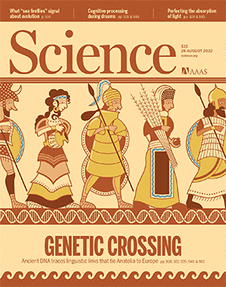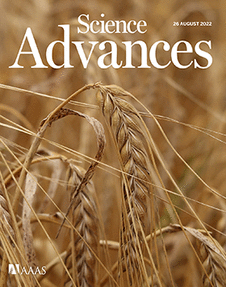How did the giraffe get its long neck? That question has enthralled scientists for centuries. Charles Darwin assumed the driver of natural selection was food, as animals with longer necks could reach higher trees and have their own private food supply with little competition from other species. But a newly analyzed fossil of an ancient giraffe relative suggests there might be more to the story: Competition for mates could have also influenced neck evolution.
“It’s a cool story about an amazing sexual weapon,” says Ted Stankowich an evolutionary ecologist at California State University, Long Beach, who was not involved with the work.
In 1996, in a 15-million-year-old rock formation in China’s far northwest, paleontologists unearthed an unusual fossil with a braincase and some vertebrae. Its skull was thickened at the base, where it had been attached to an enlarged neck vertebra. Researchers first wondered whether it might be an ancient relative of cows or sheep but weren’t sure because its teeth and bones were so large, recalls Tao Deng, a paleontologist at the Chinese Academy of Sciences’s (CAS’s) Institute of Vertebrate Paleontology and Paleoanthropology. Only years later, when a CT scan revealed the inner ear bones of the “strange beast,” did they realize it was a giraffoid, one of a group of animals that includes today’s okapi and giraffes and several other extinct giraffelike species.
Deng and a CAS colleague, paleontologist Shi-Qi Wang, did a CT scan to examine how its bones were formed and arranged. In addition to the unusually thick bones of the neck, they found a hand-size bony disk with a horny “helmet” on the top of its head. They analyzed how the vertebrae interlocked and did computer simulations to learn how the head and neck would react to impacts. They even probed the chemistry of the creature’s tooth enamel to find out what it ate. “Every angle that the researchers could have explored … was covered,” says Rob Simmons, a behavioral ecologist at the University of Cape Town who was not involved with the work.
Deng and Wang then compared the data with those on other giraffoids and animals, including wild sheep and musk ox, which lock horns or butt heads to compete for mates. The fossil’s vertebrae were not just thicker than those of other animals, but they also had more surface area in contact with the base of the skull and each other. “It’s the thickness of the vertebrae that makes [the fossil] very unusual,” says Jin Meng, a co-author at the American Museum of Natural History. The simulations revealed these modifications helped keep the head from snapping forward too far when hit.
The researchers conclude that the creature’s horny helmet was a powerful buttress for jousting with other males, they report today in Science. The researchers named the fossil Discokeryx xiezhi, after a Chinese legendary horned creature that had the power to distinguish right from wrong. “They unequivocally show that this little giraffe must have used its helmeted head for combat,” Simmons says.
Other extinct giraffoids had a variety of headgear, including club-shaped, meter-long horns. Modern giraffes have bony headgear, too: The bone that forms the helmet in D. xiezhi becomes small horns called ossicones, sometimes used by males to jab the necks of rivals as they swing their heads and necks like clubs. But among giraffelike animals, D. xiezhi is the first example of a head-butter, says María Ríos Ibáñez, a paleontologist at NOVA School of Science and Technology. She describes head-butting as “a much more direct, aggressive form of competitive behavior” than the giraffe’s “necking.”
If D. xiezhi evolved its special headgear to compete for mates, then it’s possible sexual selection also played a role in the development of other species’ headgear—and necks, Wang says. “Neck evolution is very fast and flexible and depends on the male’s fighting style,” she says. According to that thinking, the ability of giraffes to eat leaves at the tops of trees could have been a fortuitous side benefit, rather than a driving force, in the evolution of giraffes’ long necks. (Simmons has made that argument for years because even though both males and females have long necks, the male's continues to grow bigger with age, whereas the female's does not.)
Researchers can’t say whether natural selection or sexual selection made the giraffe such an exotic looking beast. But, Simmons says, “I wish Charles Darwin were alive for this discussion. He’d be bowled over.”









